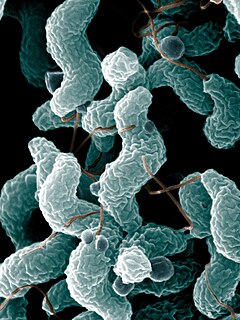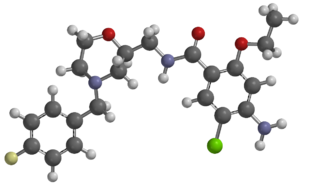A DNA virus is a virus that has DNA as its genetic material and replicates using a DNA-dependent DNA polymerase. The nucleic acid is usually double-stranded DNA (dsDNA) but may also be single-stranded DNA (ssDNA). DNA viruses belong to either Group I or Group II of the Baltimore classification system for viruses. Single-stranded DNA is usually expanded to double-stranded in infected cells. Although Group VII viruses such as hepatitis B contain a DNA genome, they are not considered DNA viruses according to the Baltimore classification, but rather reverse transcribing viruses because they replicate through an RNA intermediate. Notable diseases like smallpox, herpes, and the chickenpox are caused by such DNA viruses.

Sleep paralysis is when, during waking up or falling asleep, a person is aware but unable to move or speak. During an episode, one may hallucinate, which often results in fear. Episodes generally last less than a couple of minutes. It may occur as a single episode or be recurrent.

Peripatric speciation is a mode of speciation in which a new species is formed from an isolated peripheral population. Since peripatric speciation resembles allopatric speciation, in that populations are isolated and prevented from exchanging genes, it can often be difficult to distinguish between them. Nevertheless, the primary characteristic of peripatric speciation proposes that one of the populations is much smaller than the other. The terms peripatric and peripatry are often used in biogeography, referring to organisms whose ranges are closely adjacent but do not overlap, being separated where these organisms do not occur—for example on an oceanic island compared to the mainland. Such organisms are usually closely related ; their distribution being the result of peripatric speciation.

Endemism is the ecological state of a species being unique to a defined geographic location, such as an island, nation, country or other defined zone, or habitat type; organisms that are indigenous to a place are not endemic to it if they are also found elsewhere. The extreme opposite of endemism is cosmopolitan distribution. An alternative term for a species that is endemic is precinctive, which applies to species that are restricted to a defined geographical area.
Togaviridae is a family of RNA viruses. Humans, mammals, birds, and mosquitoes serve as natural hosts. Currently, 31 species are placed in this family in a single genus, Alphavirus. Diseases associated with alphaviruses include arthritis and encephalitis.

Ethylmorphine is an opioid analgesic and antitussive.

A radio-quiet neutron star is a neutron star that does not seem to emit radio emissions, but is still visible to Earth through electromagnetic radiation at other parts of the spectrum, particularly x-rays and gamma rays.

Aporphine is an alkaloid that forms the core of a class of quinoline alkaloids. It can exist in either of two enantiomeric forms, (R)-aporphine and (S)-aporphine.

Epsilonproteobacteria are a class of Proteobacteria. All species of this class are, like all Proteobacteria, Gram-negative.

The avermectins are a series of drugs and pesticides used to treat parasitic worms and insect pests. They are a 16-membered macrocyclic lactone derivatives with potent anthelmintic and insecticidal properties. These naturally occurring compounds are generated as fermentation products by Streptomyces avermitilis, a soil actinomycete. Eight different avermectins were isolated in four pairs of homologue compounds, with a major (a-component) and minor (b-component) component usually in ratios of 80:20 to 90:10. Other anthelmintics derived from the avermectins include ivermectin, selamectin, doramectin, eprinomectin, moxidectin, and abamectin.

Mosapride is a gastroprokinetic agent that acts as a selective 5HT4 agonist. The major active metabolite of mosapride, known as M1, additionally acts as a 5HT3 antagonist, which accelerates gastric emptying throughout the whole of the gastrointestinal tract in humans, and is used for the treatment of gastritis, gastroesophageal reflux disease, functional dyspepsia and irritable bowel syndrome. It is recommended to be taken on an empty stomach (i.e. at least one hour before food or two hours after food).

Urapidil is a sympatholytic antihypertensive drug. It acts as an α1-adrenoceptor antagonist and as an 5-HT1A receptor agonist. Although an initial report suggested that urapidil was also an α2-adrenoceptor agonist, this was not substantiated in later studies that demonstrated it was devoid of agonist actions in the dog saphenous vein and the guinea-pig ileum. Unlike some other α1-adrenoceptor antagonists, urapidil does not elicit reflex tachycardia, and this may be related to its weak β1-adrenoceptor antagonist activity, as well as its effect on cardiac vagal drive. Urapidil is currently not approved by the U.S. Food and Drug Administration, but it is available in Europe.

Galanolactone is a diterpenoid lactone first isolated from ginger. It is known to be present in acetone extracts of ginger, and appears to be an antagonist at 5-HT3 receptors.

Wogonin is an O-methylated flavone, a flavonoid-like chemical compound which was found in Scutellaria baicalensis.
Flavonolignans are natural phenols composed of a part flavonoid and a part lignan.

Prunetin is an O-methylated isoflavone, a type of flavonoid. It has been isolated for the first time by Finnemore in 1910 in the bark of Prunus emarginata. Prunetin isolated from pea roots can act as an attractant for Aphanomyces euteiches zoospores. It is also an allosteric inhibitor of human liver aldehyde dehydrogenase.
Deccanolestes is a scansorial, basal Euarchontan from the Late Cretaceous (Maastrichtian) and Paleocene Intertrappean Beds of Andhra Pradesh, India. It may be closely related to Sahnitherium. Deccanolestes has been referred to Palaeoryctidae in the past, but recent evidence has shown the it is either the most basal Euarchontan, as the earliest known Adapisoriculid, or as a stem-afrotherian.

Chebulic acid is a phenolic compound isolated from the ripe fruits of Terminalia chebula.

Bakuchiol is a meroterpene in the class terpenophenol.
The Selenomonadales are an order of bacteria within the class Negativicutes; unlike most other members of Firmicutes, they are Gram-negative. The phylogeny of this order was initially determined by 16S rRNA comparisons. More recently, molecular markers in the form of conserved signature indels (CSIs) have been found specific for all Selenomonadales species. On the basis of these markers, the Selenomonadales are inclusive of two distinct families, and are no longer the sole order within the Negativicutes. Several CSIs have also been found specific for both families, Sporomusaceae and Selenomonadceae. Samples of bacterial strains within this order have been isolated from the root canals of healthy human teeth.















